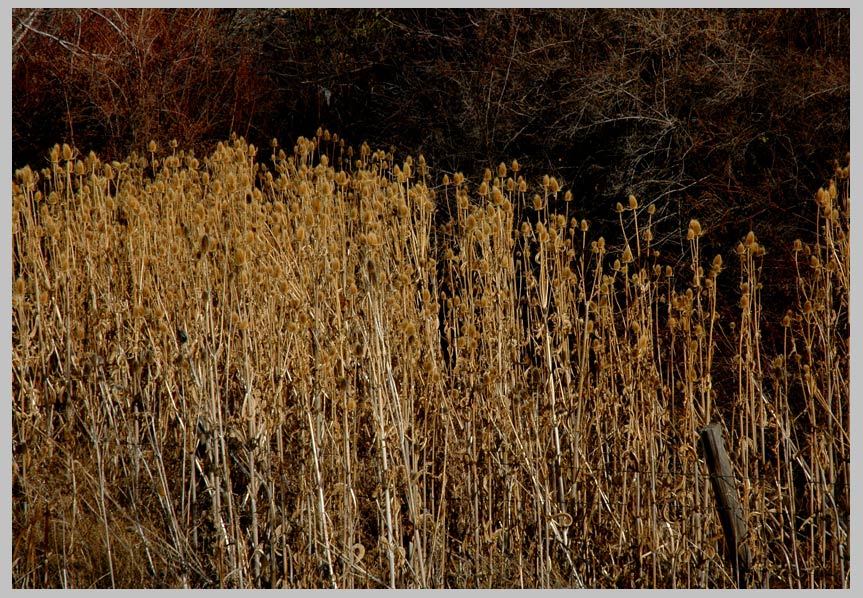
Fuller's Teasel, explosive growth in riparian area,
Little Sheep Canyon, near Imnaha, Oregon (Dipsica fullonum).
Eurasian native, invasive in especially the West of North America—

Fuller's Teasel, explosive growth in riparian area,
Little Sheep Canyon, near Imnaha, Oregon (Dipsica fullonum).
Eurasian native, invasive in especially the West of North America—
Teasel is an interesting plant in many respects. First, let me say
that it is native to the southern part of the Alps, where it has become
rare. (I've only seen it in ornamental gardens, where Teasel is planted
for its beauty, and have never actually encountered a specimen in the
wild.) Its common name refers to an archaic sense of tease, that of
combing the surface of woolen cloth to raise a nap. In past times when
wool was still harvested and processed on the farmstead, dried teasel
heads were gathered in the fall evidently for this purpose.
Teasel is a low-density weed of rural ditches in Ohio. But I was surprised
to see how explosive it can be, forming unnaturally high-density clusters
like the one shown above. I noticed these clusters for the first time in
Northeast Oregon in riparian areas, especially ones grazed by equally
high densities of cattle.
At a distance, Teasel looks like a thistle—which are all members of
the Aster family—but it isn't. It's a member of its own group, the
Dipsacaceae family.
See the summer photos below for some of this
introduced plant's other unique features.
ON THE WAY OF NON-VIOLENCE
We shape the world and the world shapes us.
The way of non-violence is not merely the deeply held intention to live
a life without conflict and the use of force; it of necessity actively seeks
to make explicit the contradictions of thought, culture and convention
that lead to violence (and waste) of any kind, against oneself, against
one’s fellow human beings, or against the Earth. The voice of frustration
of the current era, amplified a thousand fold by the populist rhetoric of ad
hominem Attack Radio and TV, flirts with violence of the most insidious
kind as a misleading means of releasing equally misguided rage. This is
a profound mistake. The way of non-violence, as an alternative, takes the
rule of law and civil stability as its point of departure, and seeks by means
of argument, dialogue, or, when necessary, civil disobedience, to widen the
circle of ethical awareness and discourse. It seeks to include in a radical and
uncompromising way the whole of both the human community and the
whole of the living Earth.
THE LITTLE CLAVIER please preview 150 of 631 pages
w/ my black & white photography [opens in new window]
All Photographs & texts by Cliff Crego © 2011 picture-poems.com
(created: XI.19.2007)